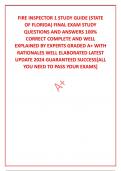FIRE INSPECTOR 1 STUDY GUIDE (STATE
OF FLORIDA) FINAL EXAM STUDY
QUESTIONS AND ANSWERS 100%
CORRECT COMPLETE AND WELL
EXPLAINED BY EXPERTS GRADED A+ WITH
RATIONALES WELL ELABORATED LATEST
UPDATE 2024 GUARANTEED SUCCESS[ALL
YOU NEED TO PASS YOUR EXAMS]
,
, Oxidation is a chemical reaction involving the combination of oxygen and other materials.
Fire Triangle HEAT, OXYGEN, FUEL
Fire Tetrahedron FUEL, OXYGEN, HEAT, CHEMICAL REACTION
Air consists of 21 Percent Oxygen
Potential Energy energy possessed by an object that may be released
Chemical Heat Energy Energy that is released when two or more chemicals combine and react with
one and another. Chemical heat energy is the most common source of heat in combustion reactions.
Mechanical Heat EnergyForm of energy generated by friction or compression.
Conduction Transfer of heat within an object or to another object by direct contact.
Convection Transfer of heat energy from a fluid to a solid
Radiation Transmission of energy as an electromagnetic wave, light waves, radio waves...
Class A Fires Involve ordinary, solid, combustible materials such as wood, cloth, paper, rubber, and
many plastics
Class B Fires Involve flammable and combustible liquids and gasses such as gasoline, oil, lacquer...
Class C Fires Involve energized electrical equipment
Class D Fires Involve combustible metals such as aluminum
Class K Fires Involve oils and greases normally found in commercial kitchens
Fire Development Incipient Stage, , Growth Stage, Fully Developed, and Decay
Thermal Layering Tendency of gasses to separate into layers according to temperature.
Rollover Describes a condition where the unburned fire gases accumulated at the top of a
compartment ignite and flames propagate through the hot-gas layer
Fully Developed Stage Occurs when all combustible materials in the compartment are burning.
Factors that affect Fire Fuel, Location, Compartment Volume, Ventilation, Ambient Conditions such
as wind, humidity..
Bearing Wall Wall that supports itself and the weight of the roof
Type 1 Construction Non or Limited Combustible materials. Highest Safety Levels.
Type 2 Construction Low Fire Risk, Materials won't contribute to the spread.
Type 3 Construction Used in schools, churches, mercantile. Exterior walls are non-combustible.
Type 4 Construction Heavy Timber, Large Dimensioned lumber.
Type 5 Construction Commonly known as wood frame
Assembly Occupancies 50 or more people, Churches, Arenas, Theaters..
The inspector must have a through knowledge and understanding of the following items: Enabling
legislation, State/Local Statues, ways to alter State/Local Statues




